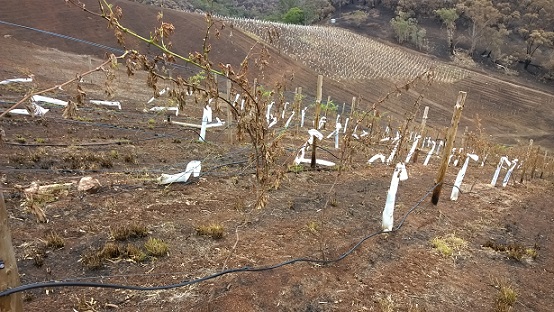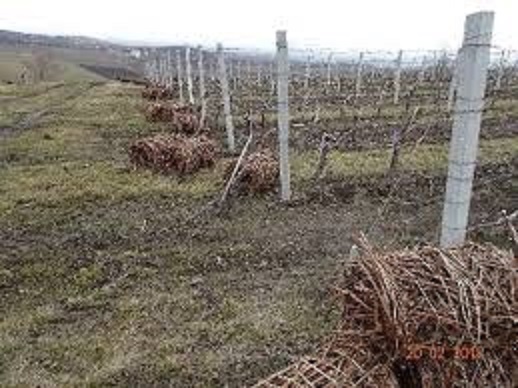The consensus among veteran firefighters and climate scientists was that record high temperatures and fire extent were linked, and due to climate change. Dramatic television coverage meant that the world had impressions of these apocalyptic-like scenes, along with frequent mention of the causal climate change. One implication is that the world became more aware of this one risk associated with climate change, though of course there are others in floods, hurricanes and drought.

Wildfires can be very destructive to vineyards and their infrastructure, such as wooden posts and irrigation lines, and of course to winery buildings (as Canopy has reported here and here). While vineyards do not readily burn, the radiant high temperatures kill leaves and sometimes vines. Smoke taint may impact the fruit and wine as well, especially after veraison exposure.
Perhaps the most significant short to long-term impact will be on global vineyard regions and their climates. For any one region, traditionally able to ripen certain well-suited varieties, we find that over the last few decades these varieties ripen earlier, and often with higher potential alcohol. Indeed, some regions are now evaluating alternate and later-maturing varieties, different from those which created the region’s reputation.
Climate change will disturb the very essence of the ‘terroir’ concept, and regional reputation.
Most of the populace now seem to believe, along with the great majority of scientists, that climate change is real and threatening. It is no longer a question of adaptation, we should think of mitigation, that is preventing climate change happening. We must stop treating the atmosphere as a sewer for CO2 and other “greenhouse” gases.
Possible mitigation strategies for the grape and wine sector
Break the bottle habit
Why are we presented with wine only in glass bottles, when it is well recognised that it is such an environmentally degrading form of packaging? Glass bottles have been around since the 17th century; is it not time to modernise the container as other liquid sellers have done?Carbon footprint studies (Life Cycle Analyses) were presented in my first article and I summarised these for the grape and wine sector.
.jpg)
Use of ancient packaging (heavy, round, tapered glass bottles) and high transport energy requirements account for the majority of the wine’s carbon footprint in most studies, not surprising since most wine is not consumed locally. Some wine is shipped halfway around the world, although ship transport in bulk is more efficient than bottles by road.
The first serious studies into replacement packaging, at least for cheaper, ready-to-drink wine, must surely soon start (I know of one only). Cheaper wine is often around 50% of the market for the UK, USA and Australia, and so less carbon-polluting packaging will make a big impact. For such studies, consumer acceptance will be critical. I think many environmentally-aware consumers are ready to give up their use of glass bottles for the sake of helping to fight climate change. Do you?
There are some options which might extend the life of glass bottles, like in-store refilling and/or recycling with a container deposit scheme, but there is also the possibility of cardboard or even paper containers with oxygen impermeable barriers, which may be found for some European producers. These will have square format and be lighter, and easily recyclable/biodegradable, maybe in 1L or 1.5L capacity. They, like pouches, can be used in the kitchen to fill decanters on restaurant or home dining tables.

Other mitigation strategies
Vineyard and winery waste products (biomass) should be used for electricity generation to replace that from fossil fuels. Prunings from the vineyard can be economically collected as bales (above), air-dried and chipped cheaply and combusted to produce heat or electricity. Stalks from the winery can also be combusted, although pomace from the presses will require drying. Biomass constitutes 30-40% of the weight of grapes, and presently carries a cost of disposal in many operations.
.jpg)
These biomass products can also be treated with various pyrolysis methods, for a range of products such as syngas, wood vinegar, biochar, bio-oil and even hydrogen. Smaller portable plants (like the one above) are now available which can be utilized for medium size wineries or shared communally for smaller wineries. Generation of electricity from syngas has advantages over solar energy where requirements are large, as for wineries during vintage periods. It is available 24/7 and does not require large land/roof areas of solar collectors. Wood vinegar has properties for plant growth stimulation at low concentrations, and as an organic herbicide at higher concentrations. Biochar can be mixed with vineyard soil as an amendment and is a means of sequestering carbon. This latter option is regarded by some climate scientists as important, as a means of taking back some CO2 from the atmosphere.
Solar and wind renewable energy also have a part to play in vineyards and wineries. Electric-powered vineyard tractors are being developed. Nitrogen fertiliser has a significant carbon cost, how about conveniently growing your own in the vineyard, using solar energy? It is possible.
CO2 emissions from the winery
In my first column for Canopy, I mentioned a few (European) equipment manufacturers and wineries tackling the problem of emission of fermentation CO2, but there has been little take-up of the technology. Do most global wineries not care about putting CO2 into the atmosphere?The problem is not widely known among consumers now, but it soon will be, as sources of the problem of climate change receive wider coverage.
How long will it be before we see a logo like the one below (designed by my daughter and myself) printed on a wine package, whatever the format? Which will be the first winery in your region to make the not so brave step to stop polluting the atmosphere with fermentation CO2? The technology is available. Is there the will?
-1.jpg)













.png)






